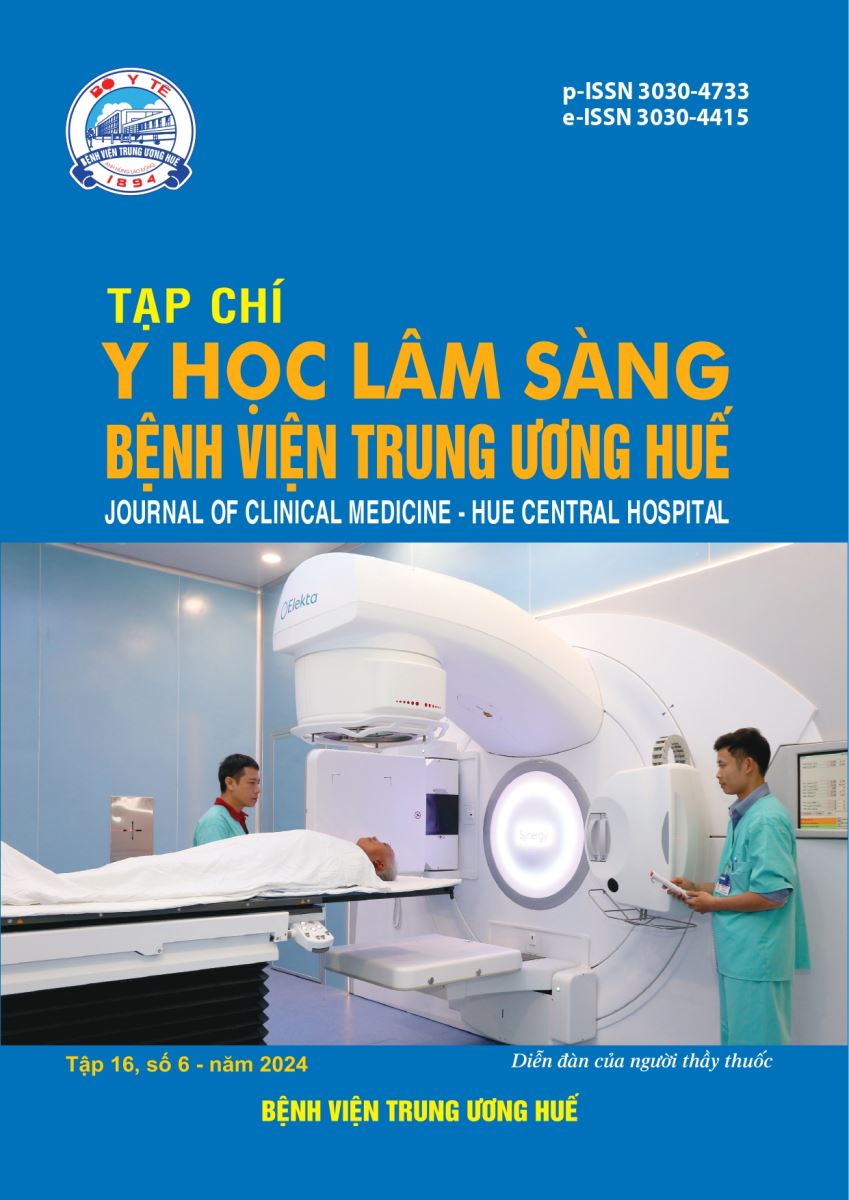Tóm tắt
Đặt vấn đề: Phẫu thuật cắt gan có thể giúp lấy sạch sỏi, loại bỏ đường mật bị chít hẹp và nhu mô gan bị xơ teo ở các trường hợp sỏi mật tái phát. Do đó, chúng tôi thực hiện nghiên cứu với mục tiêu đánh giá kết quả phẫu thuật cắt gan điều trị sỏi mật tái phát.
Đối tượng, phương pháp: Gồm có 34 bệnh nhân sỏi mật tái phát được điều trị bằng phẫu thuật cắt gan từ tháng 01/2019 đến tháng 6/2022.
Kết quả: Tỷ lệ nam/nữ là 2,4/1, độ tuổi trung bình là 53,9 ± 8,8. Chỉ định cắt gan do sỏi gồm có 64,7% gan xơ teo, 29,4% áp xe gan - đường mật và 5,9% theo dõi u đường mật. Phẫu thuật cắt thùy gan trái chiếm 88,2%, cắt gan trái là 8,8% và cắt phân thùy sau 2,9%. Thời gian phẫu thuật trung bình là 179,8 ± 36,6 phút (155 - 210), và lượng máu mất là 225,7 ± 98,6 ml (170 - 350). Kết quả sạch sỏi ban đầu là 88,2% và kết quả sạch sỏi sau cùng là 94,1%. Biến chứng sau phẫu thuật có 14,7% nhiễm trùng vết mổ và 5,9% áp xe ổ bụng.
Kết luận: Phẫu thuật cắt bỏ thùy gan đã bị thương tổn do sỏi mật tái phát là phương pháp điều trị an toàn và hiệu quả. Việc lựa chọn phù hợp các trường hợp phẫu thuật cắt gan sẽ có kết quả điều trị tốt hơn.
Từ khóa: Sỏi mật, sỏi mật tái phát, phẫu thuật cắt gan.
Tài liệu tham khảo
Sakpal SV, Babel N, Chamberlain RS. Surgical management
of hepatolithiasis. HPB. 2009;11:194-202.
Krige JEJ. Liver Resection for Complicated Hepatolithiasis
Archives of Surgery. 2006;141:713.
Li SQ, Liang LJ, Peng BG, Hua YP, Lv MD, Fu SJ, et al.
Outcomes of liver resection for intrahepatic stones: a
comparative study of unilateral versus bilateral disease.
Annals of surgery. 2012;255:946–53.
Kim J, Cho JY, Han H-S, Yoon Y-S, Choi Y, Lee JS, et al.
Validation of a difficulty scoring system for laparoscopic
liver resection in hepatolithiasis. Surgical Endoscopy.
;35:1148-55.
Tan HL, Koh YX, Lye WK, Lee SY, Goh BKP, Tan SS, et
al. Surgical management decreases disease recurrence risk
in recurrent pyogenic cholangitis. ANZ journal of surgery.
;88:E659-63.
Lorio E, Patel P, Rosenkranz L, Patel S, Sayana H.
Management of Hepatolithiasis: Review of the Literature
Current Gastroenterology Reports. 2020;22:30.
Li H, Zheng J, Cai J-Y, Li S-H, Zhang J-B, Wang X-M, et
al. Laparoscopic VS open hepatectomy for hepatolithiasis:
An updated systematic review and meta-analysis. World
journal of gastroenterology. 2017;23:7791-806.
Li C, Wen T. Surgical management of hepatolithiasis:
A minireview. Intractable & Rare Diseases Research.
;6:102-5.
Tazuma S, Unno M, Igarashi Y, Inui K, Uchiyama K, Kai
M, et al. Evidence-based clinical practice guidelines
for cholelithiasis 2016. Journal of gastroenterology.
;52:276-300.
Suzuki Y, Mori T, Yokoyama M, Kim S, Momose H,
Matsuki R, et al. A proposed severity classification system
for hepatolithiasis based on an analysis of prognostic factors
in a Japanese patient cohort. Journal of gastroenterology.
;53:854-60.
You M su, Lee SH, Kang J, Choi YH, Choi JH, Shin B, et al.
Natural Course and Risk of Cholangiocarcinoma in Patients
with Recurrent Pyogenic Cholangitis: A Retrospective
Cohort Study. Gut and Liver. 2019;13:373-9.
Cheon YK, Cho YD, Moon JH, Lee JS, Shim CS. Evaluation
of long-term results and recurrent factors after operative
and nonoperative treatment for hepatolithiasis. Surgery.
;146:843-53.
Li EL, Yuan RF, Liao WJ, Feng Q, Lei J, Yin XB, et al.
Intrahepatic bile duct exploration lithotomy is a useful
adjunctive hepatectomy method for bilateral primary
hepatolithiasis: an eight-year experience at a single centre.
BMC surgery. 2019;19:16.
Feng X, Zheng S, Xia F, Ma K, Wang S, Bie P, et al.
Classification and management of hepatolithiasis: A highvolume, single-center’s experience. Intractable & rare diseases research. 2012;1:151-6.
Chen D-W, Tung-Ping Poon R, Liu C-L, Fan S-T, Wong
J. Immediate and long-term outcomes of hepatectomy for
hepatolithiasis. Surgery. 2004;135:386-93.
Uenishi T, Hamba H, Takemura S, Oba K, Ogawa M,
Yamamoto T, et al. Outcomes of hepatic resection
for hepatolithiasis. American journal of surgery.
;198:199-202.
Clemente G, De Rose AM, Murri R, Ardito F, Nuzzo G,
Giuliante F. Liver Resection for Primary Intrahepatic
Stones: Focus on Postoperative Infectious Complications.
World Journal of Surgery. 2016;40:433-9.
| Đã xuất bản | 30-12-2024 | |
| Toàn văn |
|
|
| Ngôn ngữ |
|
|
| Số tạp chí | Tập 16 Số 6 (2024) | |
| Phân mục | Nghiên cứu | |
| DOI | 10.38103/jcmhch.16.6.4 | |
| Từ khóa | Từ khóa: Sỏi mật, sỏi mật tái phát, phẫu thuật cắt gan. |

công trình này được cấp phép theo Creative Commons Attribution-phi thương mại-NoDerivatives 4.0 License International .
Bản quyền (c) 2024 Tạp chí Y học lâm sàng Bệnh viện Trung Ương Huế

